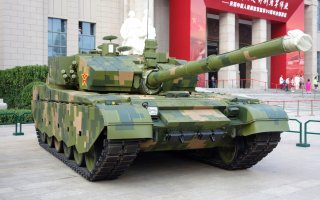How China Could Land Its Best Tanks in Taiwan
Hint: It's all thanks to a new engine.
Here's What You Need to Know: An ability to transport a Type T99 main battle tank would be massively significant to any kind of ground war effort.
The People’s Liberation Army will soon be able to airlift full-scale Chinese Main Battle Tanks on board an upgraded Y-20 cargo plane, now being outfitted with a first-of-its-kind domestically built engine.
The new WS-20 engine, which has not as of yet been formally announced as having integrated onto the Y-20, was reportedly seen flying on the aircraft according to multiple news reports cited in the Chinese government-backed Global Times newspaper.
“The Xi'an Aircraft Industry (Group) Company Ltd under the state-owned Aviation Industry Corporation of China, the maker of the Y-20, released a photo that showed a turbofan engine with a high bypass ratio that had never been seen before, Beijing-based Aerospace Knowledge magazine reported on Saturday,” the Global Times reports.
A new WS-20 equipped Y-20 would, according to the paper, be able to operate with much more thrust and less fuel as well as be able to take off and land on shorter runways. An increased ability to operate in more austere circumstances certainly increases the tactical scenarios in which a Y-20 could help deploy troops, equipment, supplies, weapons and even large platforms such as tanks.
An ability to transport a Type T99 main battle tank would be massively significant to any kind of ground war effort, especially since the U.S. Army M1Abrams tanks need to deploy overseas by boat. Air deployment of a massive tank exponentially decreases deployment attack timelines and would enable a heavy mechanized force to strike on a vastly different timetable.
“With the domestically made engines, the Y-20 can become capable of long-range or intercontinental flight while carrying heavy equipment like main battle tanks without stopping at a transit airfield for refuelling,” the Global Times reports.
The U.S. Army’s massive emphasis upon rapid reaction deployment possibilities, something which could be described as an ability to optimize expeditionary warfare, rests in large measure upon the logistical reality that heavy mechanized vehicles such as an Abrams simply cannot travel by air. This circumstance helps explain why the Army is fast-tracking an air-droppable Mobile Protected Firepower light tank vehicle. Should major threats or some kind of large scale land war quickly become urgently needed, getting armored forces to the fight would become an instant priority.
The development almost immediately brings Taiwan to mind, given that an ability to air-deploy Type T99 tanks could give attacking Chinese forces a rapid forcible entry option, and possibly be trail closely behind or accompany some kind of amphibious assault. Tank-carrying aircraft transiting from mainland China to Taiwan could of course travel much more quickly and much less visible than tank-transporting ships. This could even, quite possibly, be part of why the U.S. has been moving to sell Abrams tanks to Taiwan, a clear way to enable massive armored defense against a possible Chinese invasion.
Perhaps having Abrams tanks on the island of Taiwan could impede or slow up any Chinese ground invasion long enough to allow time for the U.S. military to intervene.
Kris Osborn is the defense editor for the National Interest. Osborn previously served at the Pentagon as a Highly Qualified Expert with the Office of the Assistant Secretary of the Army—Acquisition, Logistics & Technology. Osborn has also worked as an anchor and on-air military specialist at national TV networks. He has appeared as a guest military expert on Fox News, MSNBC, The Military Channel, and The History Channel. He also has a Masters Degree in Comparative Literature from Columbia University.
This article first appeared earlier this year.
Image: Wikimedia Commons

